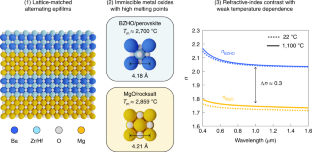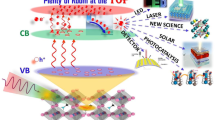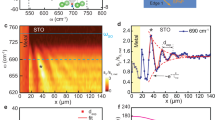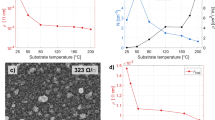Abstract
Nanophotonic materials offer spectral and directional control over thermal emission, but in high-temperature oxidizing environments, their stability remains low. This limits their applications in technologies such as solid-state energy conversion and thermal barrier coatings. Here we show an epitaxial heterostructure of perovskite BaZr0.5Hf0.5O3 (BZHO) and rocksalt MgO that is stable up to 1,100 °C in air. The heterostructure exhibits coherent atomic registry and clearly separated refractive-index-mismatched layers after prolonged exposure to this extreme environment. The immiscibility of the two materials is corroborated by the high formation energy of substitutional defects from density functional theory calculations. The epitaxy of immiscible refractory oxides is, therefore, an effective method to avoid prevalent thermal instabilities in nanophotonic materials, such as grain-growth degradation, interlayer mixing and oxidation. As a functional example, a BZHO/MgO photonic crystal is implemented as a filter to suppress long-wavelength thermal emission from the leading bulk selective emitter and effectively raise its cutoff energy by 20%, which can produce a corresponding gain in the efficiency of mobile thermophotovoltaic systems. Beyond BZHO/MgO, computational screening shows that hundreds of potential cubic oxide pairs fit the design principles of immiscible refractory photonics. Extending the concept to other material systems could enable further breakthroughs in a wide range of photonic and energy conversion applications.
This is a preview of subscription content, access via your institution
Access options
Access Nature and 54 other Nature Portfolio journals
Get Nature+, our best-value online-access subscription
$29.99 / 30 days
cancel any time
Subscribe to this journal
Receive 12 print issues and online access
$259.00 per year
only $21.58 per issue
Buy this article
- Purchase on Springer Link
- Instant access to full article PDF
Prices may be subject to local taxes which are calculated during checkout





Similar content being viewed by others
Data availability
Raw data are available via Deep Blue Data (a public repository hosted by the University of Michigan) at https://doi.org/10.7302/bvre-r767. The optical spectra used to calculate the TPV FOM were obtained from ref. 1.
Code availability
Analysis code for raw data is available via Deep Blue Data at https://doi.org/10.7302/bvre-r767. Our open-source code to find lattice-matched immiscible oxides is available via GitHub at https://github.com/sean-mcsherry/lattice_matching_oxides.
References
Burger, T., Sempere, C., Roy-Layinde, B. & Lenert, A. Present efficiencies and future opportunities in thermophotovoltaics. Joule 4, 1660–1680 (2020).
LaPotin, A. et al. Thermophotovoltaic efficiency of 40%. Nature 604, 287–291 (2022).
Bitnar, S. et al. Practical thermophotovoltaic generators. Semiconductors 38, 941–945 (2004).
Nakagawa, N., Ohtsubo, H., Waku, Y. & Yugami, H. Thermal emission properties of Al2O3/Er3Al5O12 eutectic ceramics. J. Eur. Ceram. Soc. 25, 1285–1291 (2005).
Ferguson, L. G. & Dogan, F. A highly efficient NiO-doped MgO matched emitter for thermophotovoltaic energy conversion. Mater. Sci. Eng. B 83, 35–41 (2001).
Fraas, L. M., Avery, J. E. & Huang, H. X. Thermophotovoltaic furnace–generator for the home using low bandgap GaSb cells. Semicond. Sci. Technol. 18, S247–S253 (2003).
Chirumamilla, M. et al. Metamaterial emitter for thermophotovoltaics stable up to 1400 °C. Sci. Rep. 9, 7241 (2019).
Chirumamilla, M. et al. Thermal stability of tungsten based metamaterial emitter under medium vacuum and inert gas conditions. Sci. Rep. 10, 3605 (2020).
Wang, Y. et al. Hybrid solar absorber–emitter by coherence‐enhanced absorption for improved solar thermophotovoltaic conversion. Adv. Opt. Mater. 6, 1800813 (2018).
Kim, J. H., Jung, S. M. & Shin, M. W. Thermal degradation of refractory layered metamaterial for thermophotovoltaic emitter under high vacuum condition. Opt. Express 27, 3039–3054 (2019).
Shimizu, M., Kohiyama, A. & Yugami, H. Evaluation of thermal stability in spectrally selective few-layer metallo-dielectric structures for solar thermophotovoltaics. J. Quant. Spectrosc. Radiat. Transf. 212, 45–49 (2018).
Stelmakh, V. et al. High-temperature tantalum tungsten alloy photonic crystals: stability, optical properties, and fabrication. Appl. Phys. Lett. 103, 123903 (2013).
Woolf, D. N. et al. High-efficiency thermophotovoltaic energy conversion enabled by a metamaterial selective emitter. Optica 5, 213–218 (2018).
Rinnerbauer, V. et al. High-temperature stability and selective thermal emission of polycrystalline tantalum photonic crystals. Opt. Express 21, 11482–11491 (2013).
Cui, K. et al. Tungsten–carbon nanotube composite photonic crystals as thermally stable spectral‐selective absorbers and emitters for thermophotovoltaics. Adv. Energy Mater. 8, 1801471 (2018).
Yeng, Y. X. et al. Enabling high-temperature nanophotonics for energy applications. Proc. Natl Acad. Sci. USA 109, 2280–2285 (2012).
Cho, J.-W. et al. Optical tunneling mediated sub-skin-depth high emissivity tungsten radiators. Nano Lett. 19, 7093–7099 (2019).
Chan, W. R. et al. Enabling efficient heat-to-electricity generation at the mesoscale. Energy Environ. Sci. 10, 1367–1371 (2017).
Li, P. et al. Large-scale nanophotonic solar selective absorbers for high-efficiency solar thermal energy conversion. Adv. Mater. 27, 4585–4591 (2015).
Arpin, K. A. et al. Three-dimensional self-assembled photonic crystals with high temperature stability for thermal emission modification. Nat. Commun. 4, 2630 (2013).
Arpin, K. A., Losego, M. D. & Braun, P. V. Electrodeposited 3D tungsten photonic crystals with enhanced thermal stability. Chem. Mater. 23, 4783–4788 (2011).
Kim, Y., Kim, M.-J., Kim, Y.-S., Lee, H. & Lee, S.-M. Nanostructured radiation emitters: design rules for high-performance thermophotovoltaic systems. ACS Photon. 6, 2260–2267 (2019).
Chou, J. B. et al. Enabling ideal selective solar absorption with 2D metallic dielectric photonic crystals. Adv. Mater. 26, 8041–8045 (2014).
Peykov, D., Yeng, Y. X., Celanovic, I., Joannopoulos, J. D. & Schuh, C. A. Effects of surface diffusion on high temperature selective emitters. Opt. Express 23, 9979–9993 (2015).
Dyachenko, P. N. et al. Controlling thermal emission with refractory epsilon-near-zero metamaterials via topological transitions. Nat. Commun. 7, 11809 (2016).
Lee, H.-J. et al. Hafnia-plugged microcavities for thermal stability of selective emitters. Appl. Phys. Lett. 102, 241904 (2013).
Han, S., Shin, J.-H., Jung, P.-H., Lee, H. & Lee, B. J. Broadband solar thermal absorber based on optical metamaterials for high-temperature applications. Adv. Opt. Mater. 4, 1265–1273 (2016).
Wells, M. P. et al. Temperature stability of thin film refractory plasmonic materials. Opt. Express 26, 15726–15744 (2018).
Rost, C. M. et al. Entropy-stabilized oxides. Nat. Commun. 6, 8485 (2015).
Berquist, Z. J., Gayle, A. J., Dasgupta, N. P. & Lenert, A. Transparent refractory aerogels for efficient spectral control in high‐temperature solar power generation. Adv. Funct. Mater. 32, 2108774 (2021).
Fan, D. et al. Near-perfect photon utilization in an air-bridge thermophotovoltaic cell. Nature 586, 237–241 (2020).
Omair, Z. et al. Ultraefficient thermophotovoltaic power conversion by band-edge spectral filtering. Proc. Natl Acad. Sci. USA 116, 15356–15361 (2019).
Jain, A. et al. Commentary: The Materials Project: a materials genome approach to accelerating materials innovation. APL Mater. 1, 011002 (2013).
Sasamoto, T., Mizushima, K. & Sata, T. Transpiration study of the reaction of water vapor with barium oxide. Bull. Chem. Soc. Jpn 52, 2127–2129 (1979).
Meschter, P. J., Opila, E. J. & Jacobson, N. S. Water vapor-mediated volatilization of high-temperature materials. Annu. Rev. Mater. Res. 43, 559–588 (2013).
Guler, U., Boltasseva, A. & Shalaev, V. M. Refractory plasmonics. Science 344, 263–264 (2014).
Maekawa, T., Kurosaki, K. & Yamanaka, S. Thermal and mechanical properties of perovskite-type barium hafnate. J. Alloys Compd. 407, 44–48 (2006).
Yamanaka, S. et al. Thermophysical properties of BaZrO3 and BaCeO3. J. Alloys Compd. 359, 109–113 (2003).
Durand, M. A. The coefficient of thermal expansion of magnesium oxide. Physics 7, 297–298 (1936).
Wang, X. et al. Calculation of thermal expansion coefficient of rare earth zirconate system at high temperature by first principles. Materials 15, 2264 (2022).
Ding, H. et al. Computational approach for epitaxial polymorph stabilization through substrate selection. ACS Appl. Mater. Interfaces 8, 13086–13093 (2016).
Wang, X., Lee, E., Xu, C. & Liu, J. High-efficiency, air-stable manganese–iron oxide nanoparticle-pigmented solar selective absorber coatings toward concentrating solar power systems operating at 750 °C. Mater. Today Energy 19, 100609 (2021).
Wang, H. et al. Highly efficient selective metamaterial absorber for high-temperature solar thermal energy harvesting. Sol. Energy Mater. Sol. Cells 137, 235–242 (2015).
Zou, C., Xie, W. & Shao, L. Functional multi-layer solar spectral selective absorbing coatings of AlCrSiN/AlCrSiON/AlCrO for high temperature applications. Sol. Energy Mater. Sol. Cells 153, 9–17 (2016).
Xu, J., Mandal, J. & Raman, A. P. Broadband directional control of thermal emission. Science 372, 393–397 (2021).
Mehboob, G. et al. A review on failure mechanism of thermal barrier coatings and strategies to extend their lifetime. Ceram. Int. 46, 8497–8521 (2020).
Heyd, J., Scuseria, G. E. & Ernzerhof, M. Hybrid functionals based on a screened Coulomb potential. J. Chem. Phys. 118, 8207–8215 (2003).
Kresse, G. & Furthmüller, J. Efficient iterative schemes for ab initio total-energy calculations using a plane–wave basis set. Phys. Rev. B 54, 11169–11186 (1996).
Li, W. et al. Refractory plasmonics with titanium nitride: broadband metamaterial absorber. Adv. Mater. 26, 7959–7965 (2014).
Chirumamilla, M. et al. Large-area ultrabroadband absorber for solar thermophotovoltaics based on 3D titanium nitride nanopillars. Adv. Opt. Mater. 5, 1700552 (2017).
Acknowledgements
We acknowledge financial support from the Department of Defense, Defense Advanced Research Projects Agency, under grant no. HR00112190005. The views, opinions and/or findings expressed are those of the authors and should not be interpreted as representing the official views or policies of the Department of Defense or the US Government. S.M. acknowledges support by the National Science Foundation (NSF) Graduate Research Fellowship under grant no. NSF DGE 1256260 and the Rackham Predoctoral Fellowship. M.W. and J.T.H. acknowledge financial support from the University of Michigan College of Engineering and technical support from the Michigan Center for Materials Characterization. The defect calculations used resources of the National Energy Research Scientific Computing (NERSC) Center, a Department of Energy Office of Science User Facility, supported under contract no. DEAC0205CH11231. The optical and electrical calculations were performed on Rivanna, the high-performance computing system at the University of Virginia. We offer special thanks to B. Lezzi and M. Shtein for access to the ellipsometry equipment. We also thank W. Carter, R. Hovden and A. Hunter for helpful discussions and feedback.
Author information
Authors and Affiliations
Contributions
Materials growth: M.W. and J.T.H. TEM analysis: T.M., M.W. and J.T.H. XRD: M.W. and J.T.H. Optical characterization: S.M. and A.L. Defect calculations: Z.D. and E.K. Screening code: S.M. and J.K. TPV calculations: S.M. and A.L. Funding and project administration: E.K., K.E., J.T.H. and A.L. Supervision: E.K., K.E., J.T.H. and A.L. Writing original draft: S.M., M.W., J.T.H. and A.L. Review and editing: all authors.
Corresponding authors
Ethics declarations
Competing interests
The authors declare no competing interests.
Peer review
Peer review information
Nature Nanotechnology thanks Manohar Chirumamilla, Gururaj Naik and the other, anonymous, reviewer(s) for their contribution to the peer review of this work.
Additional information
Publisher’s note Springer Nature remains neutral with regard to jurisdictional claims in published maps and institutional affiliations.
Extended data
Supplementary information
Supplementary Information
Supplementary Figs. 1–14, Sections 1–9 and Tables 1 and 2.
Rights and permissions
Springer Nature or its licensor holds exclusive rights to this article under a publishing agreement with the author(s) or other rightsholder(s); author self-archiving of the accepted manuscript version of this article is solely governed by the terms of such publishing agreement and applicable law.
About this article
Cite this article
McSherry, S., Webb, M., Kaufman, J. et al. Nanophotonic control of thermal emission under extreme temperatures in air. Nat. Nanotechnol. 17, 1104–1110 (2022). https://doi.org/10.1038/s41565-022-01205-1
Received:
Accepted:
Published:
Issue Date:
DOI: https://doi.org/10.1038/s41565-022-01205-1
This article is cited by
-
An assessment of the strategies for the energy-critical elements necessary for the development of sustainable energy sources
Environmental Science and Pollution Research (2023)



